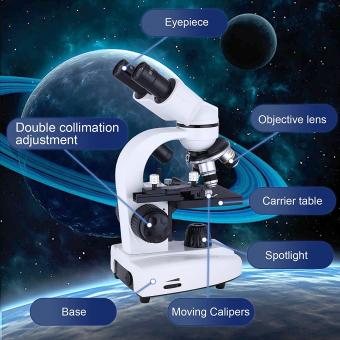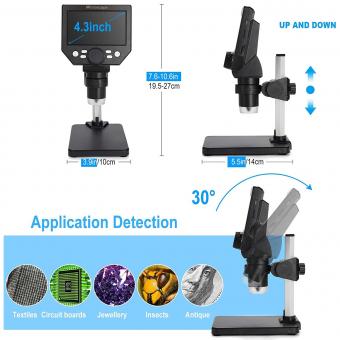Can You See Dna With A Microscope ?
No, DNA cannot be seen with a regular microscope as it is too small. DNA molecules are typically only a few nanometers in diameter, which is much smaller than the resolution limit of a light microscope. However, specialized microscopes such as electron microscopes can be used to visualize DNA molecules. These microscopes use beams of electrons instead of light to create images with much higher resolution, allowing scientists to see individual DNA molecules.
1、 DNA structure and composition
DNA, or deoxyribonucleic acid, is the genetic material that carries the instructions for the development and function of all living organisms. It is composed of four nucleotide bases: adenine (A), guanine (G), cytosine (C), and thymine (T), which are arranged in a double helix structure. The sequence of these bases determines the genetic code that is responsible for the traits and characteristics of an organism.
Can you see DNA with a microscope?
While DNA is too small to be seen with a light microscope, it can be visualized using electron microscopy. In fact, the first images of DNA were obtained using X-ray crystallography, which allowed scientists to determine the double helix structure of DNA. However, electron microscopy has since been used to directly visualize DNA molecules.
The latest point of view on DNA structure and composition is that it is not a static molecule, but rather a dynamic one that can change and adapt in response to environmental cues. This concept is known as epigenetics, which refers to changes in gene expression that are not caused by changes in the DNA sequence itself. Epigenetic modifications can be influenced by factors such as diet, stress, and exposure to toxins, and can have a significant impact on an organism's health and development.
In conclusion, while DNA cannot be seen with a light microscope, it can be visualized using electron microscopy. The latest understanding of DNA structure and composition emphasizes its dynamic nature and the importance of epigenetic modifications in gene expression.

2、 DNA extraction and purification
Can you see DNA with a microscope? The short answer is no. DNA is too small to be seen with a light microscope, which typically has a maximum resolution of around 200 nanometers. DNA molecules are only a few nanometers in diameter, making them invisible to the naked eye and most microscopes.
However, scientists can extract and purify DNA from cells and tissues, allowing them to study its structure and function. DNA extraction involves breaking open cells and separating the DNA from other cellular components using various techniques, such as centrifugation and chemical treatments. Once purified, DNA can be analyzed using a variety of methods, including gel electrophoresis, PCR, and DNA sequencing.
Recent advances in microscopy technology, such as super-resolution microscopy, have allowed scientists to visualize DNA at the nanoscale level. These techniques use fluorescent dyes and specialized microscopes to overcome the diffraction limit of light and achieve resolutions of a few nanometers. This has enabled researchers to study the organization and dynamics of DNA in cells and tissues, providing new insights into its role in gene expression and genome stability.
In summary, while DNA cannot be seen with a traditional light microscope, advances in extraction and purification techniques, as well as microscopy technology, have allowed scientists to study its structure and function at the nanoscale level.

3、 DNA visualization techniques
DNA visualization techniques have greatly evolved over the years, allowing scientists to study and analyze DNA in various ways. While it is not possible to directly see DNA with a traditional light microscope due to its small size, there are other techniques that enable its visualization.
One commonly used technique is gel electrophoresis, which separates DNA fragments based on their size. This method involves placing DNA samples in a gel matrix and applying an electric field, causing the DNA fragments to migrate through the gel. By staining the gel, the DNA bands become visible and can be analyzed.
Fluorescence in situ hybridization (FISH) is another technique that allows the visualization of specific DNA sequences within cells or tissues. FISH involves labeling DNA probes with fluorescent molecules that bind to complementary DNA sequences. When these probes are applied to the sample, they attach to their target sequences, and the fluorescence can be detected using a fluorescence microscope.
More recently, advancements in microscopy techniques have allowed for the visualization of DNA at higher resolutions. Super-resolution microscopy techniques, such as stimulated emission depletion (STED) microscopy and single-molecule localization microscopy (SMLM), have pushed the limits of optical microscopy, enabling the visualization of DNA at the nanoscale level.
It is important to note that while these techniques allow for the visualization of DNA, they do not provide a direct visual representation of the DNA molecule itself. Instead, they provide information about its presence, location, and organization within cells or tissues.
In conclusion, while DNA cannot be seen with a traditional light microscope, various DNA visualization techniques have been developed to study and analyze DNA. These techniques, such as gel electrophoresis, FISH, and super-resolution microscopy, have revolutionized our understanding of DNA and its role in biological processes.

4、 Microscopy and DNA imaging
Yes, you can see DNA with a microscope. Microscopy techniques have been instrumental in the study of DNA since its discovery in the 1950s. The most commonly used technique for visualizing DNA is fluorescence microscopy, which allows for the specific labeling and visualization of DNA molecules.
Fluorescence microscopy relies on the use of fluorescent dyes or probes that bind to DNA molecules, making them visible under the microscope. These dyes emit light of a specific wavelength when excited by a light source, allowing for the detection and imaging of DNA. This technique has been widely used in various fields of research, including genetics, molecular biology, and medicine.
In recent years, advancements in microscopy technology have further enhanced our ability to visualize DNA. Super-resolution microscopy techniques, such as stimulated emission depletion (STED) microscopy and single-molecule localization microscopy (SMLM), have pushed the limits of resolution, allowing for the visualization of DNA at the nanoscale level. These techniques have provided valuable insights into the organization and dynamics of DNA within cells.
Furthermore, the development of live-cell imaging techniques has enabled the real-time visualization of DNA dynamics and processes, such as DNA replication, transcription, and repair. This has greatly contributed to our understanding of the fundamental mechanisms underlying DNA function and regulation.
It is important to note that while microscopy allows us to visualize DNA, it does not provide direct information about the DNA sequence. For that purpose, other techniques such as DNA sequencing are required.
In conclusion, microscopy techniques have revolutionized our ability to visualize DNA, providing valuable insights into its structure, organization, and dynamics. Ongoing advancements in microscopy technology continue to push the boundaries of our understanding of DNA and its role in various biological processes.








































